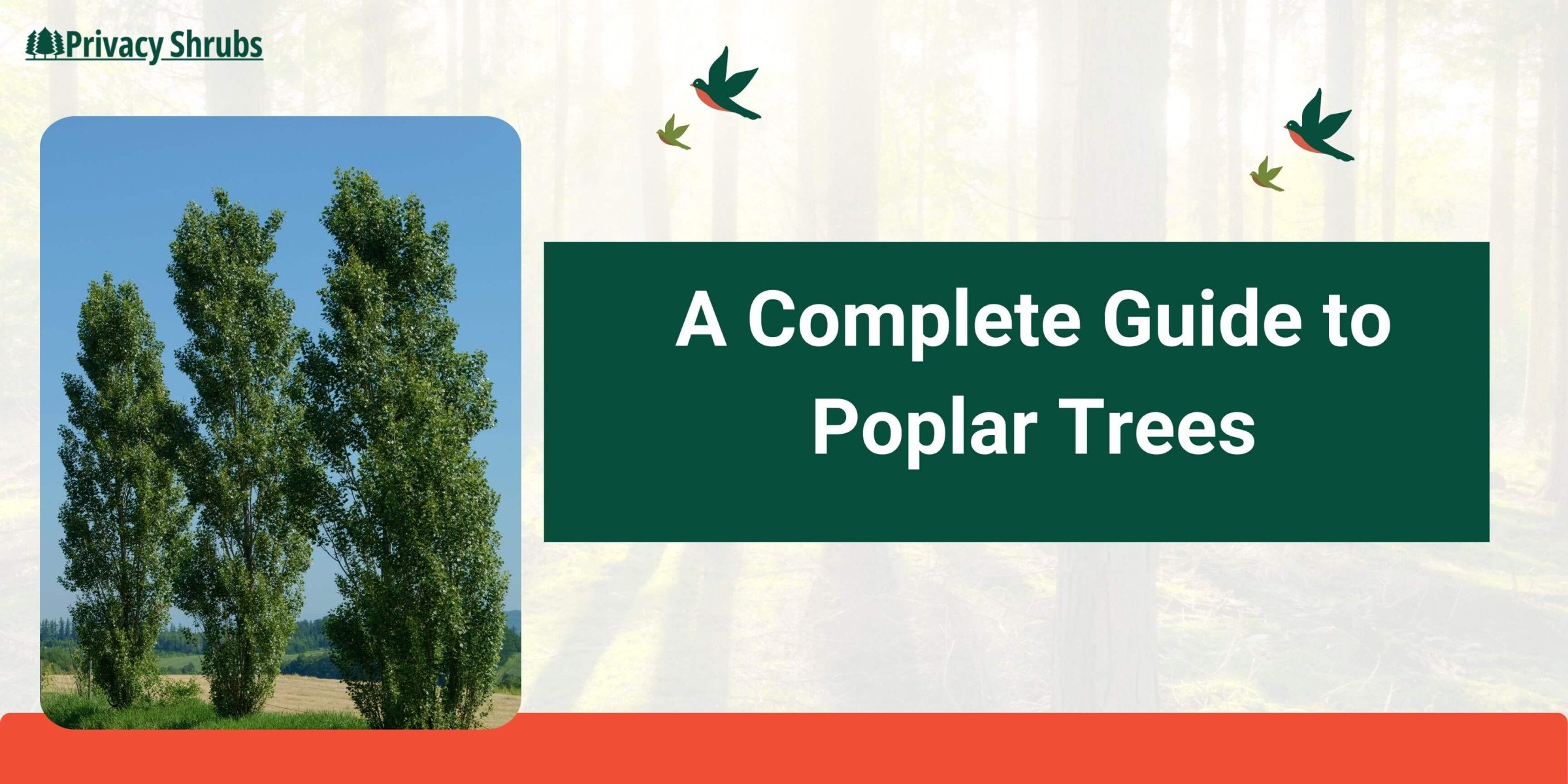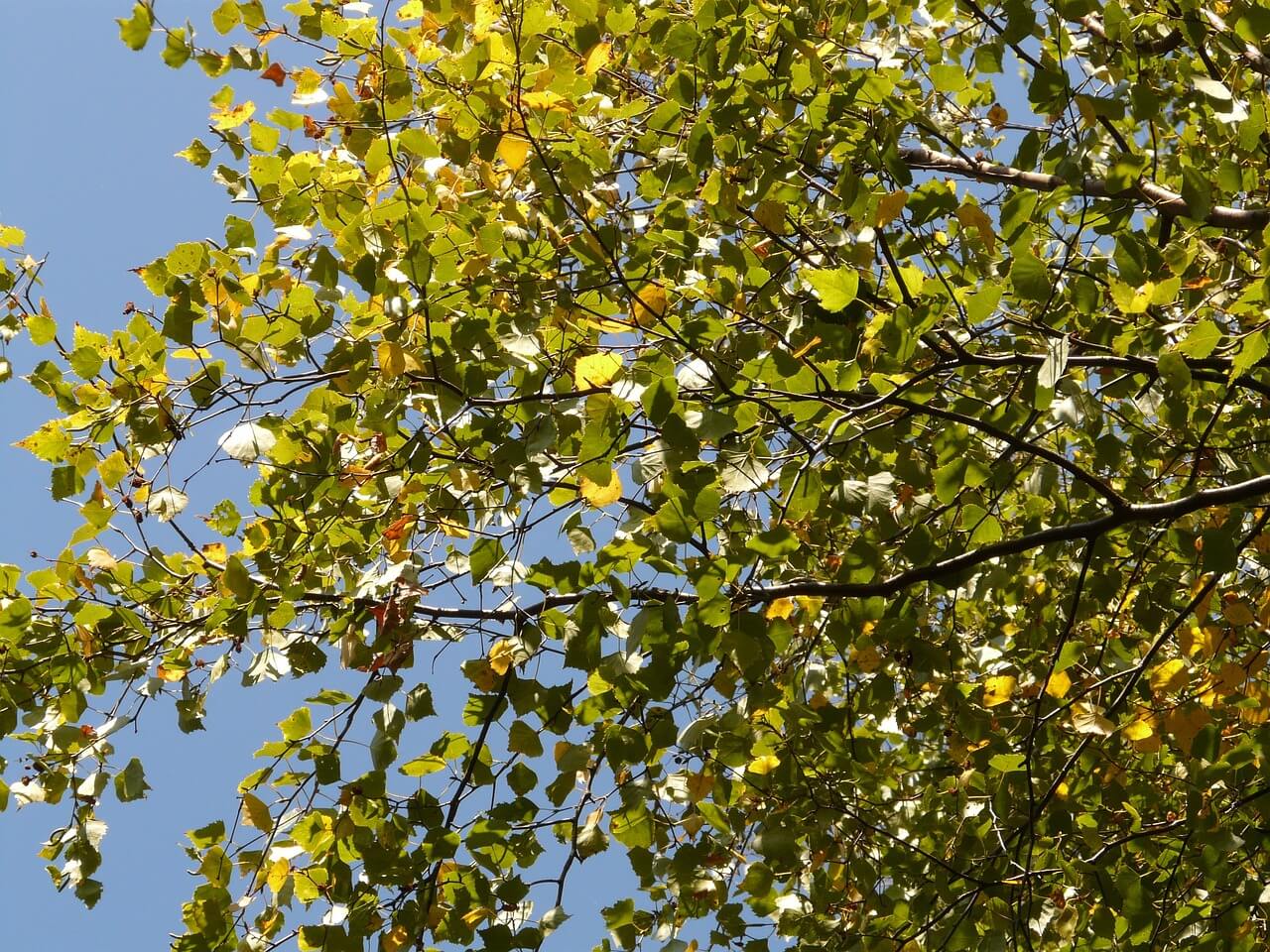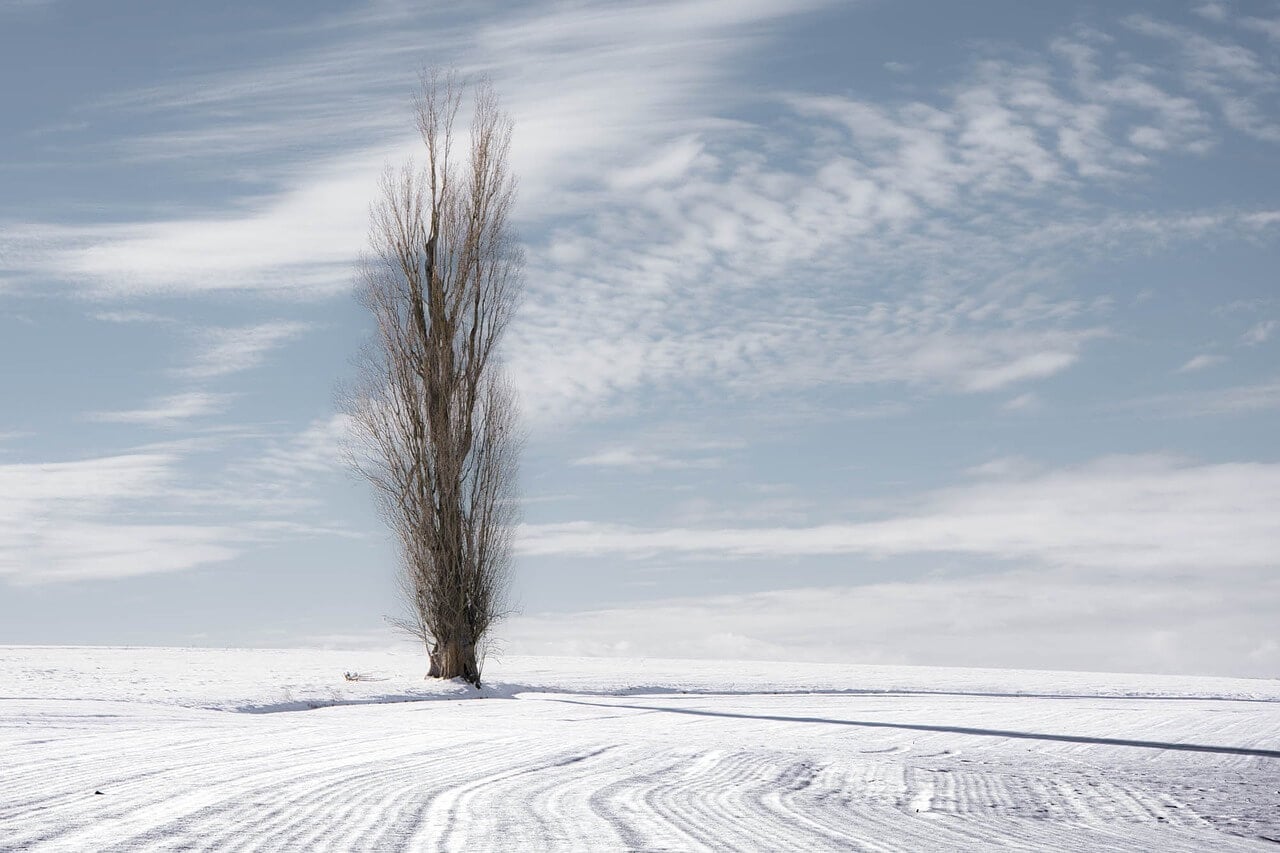Table of Contents
- Key Takeaways
- A Complete Guide to Poplar Trees: Common Types
- Poplar Tree Identification: How to Spot Them
- Poplar Tree Planting
- Watering Poplar Trees
- Fertilizing Poplar Trees
- Poplar Tree Growth Rate and Zones
- Poplar Tree Lifespan and Size
- Poplar Tree Care and Maintenance
- Landscaping with Poplar Trees
- Pros and Cons of Poplar Trees
- Common Issues with Poplar Trees
- Find the Best Deals for Poplar Trees at Privacy Shrubs
- FAQs About Poplar Trees
- Final Thoughts
Poplar trees are often used for landscaping as they are fast-growing and have pretty, fluttering leaves that change into vibrant colors in the fall and early winter. However, they can also be a handful due to aggressive root growth and pests or diseases.
In this post, you’ll get a complete guideline for poplar trees: care, planting, watering, fertilizing, pros and cons, growth zone, and growth rate.
Learn how to optimize their growth and extend their lifespan, making sure you get the most out of your poplars. We’ll also share some pros and cons, so you can decide whether or not poplars are for you.
Key Takeaways
Poplars are fast-growing trees under the genus Populus that are widespread across North America.
Poplars have varying characteristics, lifespans, and sizes based on their species.
Poplars are great for privacy landscaping, windbreaks, timber production, and environmental protection.
Poplars prefer slightly acidic, fertile, well-draining soils, and full sun exposures.
Poplars need to be planted 50 feet away from structures and about 10 to 20 feet apart from each other.
Poplars need weekly watering during their first year, fertilization in early spring to induce growth, and regular pruning during the dormant period or early spring.
Poplars need preparation before the winter months; you can use tree wraps or mulch to protect them from frost.
Poplar trees prefer to grow in USDA Hardiness Zones 3-9, or temperate climates.
Common issues with poplar trees include cankers, leaf rusts, leaf spot diseases, and aphids.
A Complete Guide to Poplar Trees: Common Types
Hybrid Poplar Tree

$89.95
$109.99
Hybrid Poplar Tree: The Fast-Growing Privacy Solution Growing an incredible 5-8 feet per year, the Hybrid Poplar Tree matures much faster than other trees, creating a dense, living screen that provides privacy and shade in record time. While other trees… View Product
Poplars are a group of trees under the genus Populus with over 32 species. Some poplars are native to North America, while others have Asian or European origins. Nowadays, poplars are so widespread that you can find them almost everywhere in the northern hemisphere.
People have used them for thousands of years for cooking, heating, construction, soil stabilization, and shade in communal areas. Their fast-growing characteristic makes them an excellent choice for landscaping and timber production. Poplars also act as windbreaks and shelterbelts by protecting the integrity of the soil from erosion.
Some of the most well-known and distinctive species are Lombardy Poplar, White Poplar, Eastern Cottonwood, and Hybrid Poplar. Let’s get to know each of them below.
Lombardy Poplar
Lombardy Poplar, or Populus nigra, is also known as Black Poplar. Native throughout Europe, the Lombardy Poplar prefers to grow mainly along rivers. It has a distinctively tall and narrow form, making it one of the best poplars for windbreaks and walkways.
White Poplar
White Poplar, or Populus alba, is native to southern Europe, Asia, and northern Africa. Similar to Lombardy Poplars, they are typically riparian and grow along rivers. White Poplar’s most distinctive feature is their leaves, which are lobed and have hairy white undersides that give them their beautiful silvery sheen.
Eastern Cottonwood
Eastern cottonwood, or Populus deltoides, is native to North America, naturally growing throughout the USA and Canada. They prefer to grow along streams and rivers, but can also be found on sandy or rocky sites. They’re known to have a broader canopy and are taller compared to other varieties.
Quaking Aspen
Quaking Aspen, or Populus tremuloides, is native to North America and widely distributed throughout the USA, Canada, and Mexico. They grow over a variety of soils but prefer well-draining ones at higher elevations. They’re known for their white bark with black scars and heart-shaped leaves that flutter prettily in the wind.
Hybrid Poplars
Known as the fastest-growing species of the bunch, hybrid poplars can grow up to 8 feet annually. They’re hybrid clones between Populus species, with the most common parent species being Eastern Cottonwood (Populus deltoides) and Lombardy Poplar (Populus nigra).
Aside from its faster growth rate, another characteristic of hybrid poplars is the lack of cotton fluff that normal poplars produce in late spring or early summer.
Poplar Tree Identification: How to Spot Them
Generally, poplars are tall trees with straight, light-colored barks that produce cotton fluff in spring and summer. However, each species has distinguishing characteristics that make poplar tree identification easy.
Poplar Tree Characteristics
Here are some distinguishing characteristics of several poplar species based on their shape, bark, sizes, and growth rate.
Species | Characteristics |
Lombardy Poplars (Populus nigra) | Have a tall, columnar shape that’s ideal for a linear border |
Eastern Cottonwoods (Populus deltoides) | Taller height and broader canopy to provide shade |
White Poplars (Populus alba) | Diamond-shaped black lenticels on barks, distinctive leaves, white undersides |
Quaking Aspen (Populus tremuloides) | White bark with black scars on bark, fluttering leaves |
Hybrid Poplars | No cotton fluff production, faster growth rate, less susceptible to diseases |
Identification of Poplar Tree Leaves
You can also identify each poplar tree species by their leaves, which you can see from the table below:
Species | Characteristics |
Lombardy Poplars (Populus nigra) | Smooth, hairless leaves, triangular shape, dark green and paler underside |
Eastern Cottonwoods (Populus deltoides) | Triangular-shaped leaves, rounded base with pointed tips |
White Poplars (Populus alba) | Leaves with serrated edges, lobed shape, and white, hairy underside |
Quaking Aspen (Populus tremuloides) | Round, flat, and easily shaken by the wind |
Hybrid Poplars | Triangular leaves, silvery green top with pale green underside |
Poplar Tree Planting
Planting your trees properly is the first step to ensuring their long-term health and successful growth. Here’s a quick summary of factors to consider:
Factors | Ideal Condition |
Location | Full sun exposure; keep poplars at least 50 feet away from structures or buildings |
Spacing | 10 to 20 feet apart |
Depth | 3 to 4 feet deep |
Soil Condition | Fertile, slightly acidic, well-draining soil |
Best Planting Practices
Poplars prefer to have full sun exposure to grow well, so make sure you give them plenty of space in between. Plant them about 10 to 20 feet apart to give them enough room to grow. The planting depth should be about 3 to 4 feet into the soil for proper root establishment or about twice the size of the root bulb.
Another factor to consider is the poplar's shallow root system, which can be invasive and cause issues with foundations, pipes, or paved walkways. Plant them at least 50 feet away from buildings or underground infrastructures to avoid this.
Soil Requirements
Poplars prefer slightly acidic, fertile, and well-draining soil. Check your soil condition before planting and see if it needs adjusting before planting. Here are some tips to improve your soil condition:
Add compost, sulfur, or iron sulfate to manage alkaline soil
Add multi-purpose, slow-release fertilizer and water soil thoroughly
Add sand or organic matter to improve soil drainage
Add mulch over planted roots to enhance moisture and temperature regulation
Watering Poplar Trees
Poplar Foliage
Poplar trees are adaptable and can grow in almost any condition, but they need proper moisture levels for optimal growth. In this section, we’ll share how you should water your poplar trees throughout their life cycle and how to spot whether or not you’re giving them enough moisture.
Watering Needs for Young vs. Mature Poplar Trees
Poplar trees need adequate watering, especially during their first year and dry periods. In their first year, water them every week and make sure they have enough sunlight.
After their first year, you can start to space-water intervals to approximately every 2 weeks. To make sure you’re watering at the right frequency, check the moisture level using your finger.
More established trees require less water and are more resistant to drought. However, in dry, hot seasons such as summer, continue to water them weekly and check the moisture levels frequently, adjusting the watering schedule to suit.
Signs of Underwatering or Overwatering
There are several ways to check on your poplar’s water needs.
Here are some signs of underwatering:
Wilting, browning, or dry leaves mean your poplar is thirsty
Soil that crumbles and dries or pulls away
Slower growth or stunting
On the other hand, here are some signs of overwatering your poplars:
Yellowing or browning leaves that feel mushy
Soggy soil and root rot with foul odor
Fungal and mold growth
Slow growth or stunting
Try to do finger checks regularly to ensure you keep their moisture at the right level because different seasons may require different levels of moisture.
Stick your finger into the soil, and if it feels dry, it’s time to water them. If there is still soil stuck to your finger, skip watering them. You can also use a moisture meter if you’re unsure.
Fertilizing Poplar Trees
Tulip Poplar Tree

$89.95
$124.99
Tulip Poplar Tree: Showcase Stunning Spring Blooms This towering giant, with its broad canopy and vibrant fall colors, will provide shade and beauty for generations to come. Its fast growth rate means you’ll enjoy its benefits sooner rather than later.… View Product
Because poplars are fast growers, they require high nutrition levels to establish their root systems. Some essential nutrients include nitrogen, phosphorus, and potassium. Other micronutrients, such as calcium and magnesium, will also help poplars to grow better.
Recommended fertilizers for poplars are NPK or slow-release multi-purpose fertilizers. Apply the fertilizer during planting and early spring annually, just after it finishes its dormant period. Water thoroughly before you apply fertilizer to help evenly distribute nutrients.
Avoid fertilizing your plants too frequently, as it may result in poor root structures due to excessive salt in the soil. Don’t fertilize your plants in the hot summer months, as the heat stress and lack of moisture can cause burnt leaves. You should also avoid fertilizing during the winter,, as they don’t need as many nutrients and can cause excessive salt in their roots.
Poplar Tree Growth Rate and Zones
Several factors can affect a poplar tree’s growth rate, such as soil quality and water availability.
Poplar Tree Growth Rate
Poplar trees are rapid-growing, meaning they mature faster than other large trees. The average growth of a poplar tree is around 3 to 5 feet annually, but some species, such as hybrid poplars, can grow up to 8 feet.
Aside from their species, other factors may affect poplar trees’ growth rate, such as:
Soil quality: Poplars need fertile soil with good aeration to grow properly. Lack of nutrition can stunt their growth and compact soils can block roots from establishing properly.
Water availability: The right amount of water means poplars can grow properly, while a lack of it can lead to stunted growth. Too much water can lead to root rot and yellowing leaves.
Sun exposure: The last essential element is sun exposure. Lack of sun exposure can lead to poplar trees that are weaker, have drooping leaand are, and prone to infestation.
Growth Zones for Poplar Trees
Poplar trees are also affected by climate. The USDA hardiness zones begin with Zone 1, the coldest region, and end in Zone 13, the warmest area. The most ideal zones for poplar trees are USDA hardiness zones 3 to 9, which means they can handle temperatures between -40 degrees F to 100 degrees F.
Poplars flourish in temperate climates with mild winters and moderate summers. Although they can survive a wide range of conditions, extended exposure to extreme heat or cold can affect their growth and stunt them.
Poplar Tree Lifespan and Size
The poplar tree’s lifespan and size will depend on its species and the condition of its environment. Make your choice by going through our list of poplar species and their characteristics!
Poplar Species | Lifespan | Height |
Lombardy Poplars (Populus nigra) | 15 to 25 years | 50 feet |
Eastern Cottonwoods (Populus deltoides) | 70 to 100 years | 100 feet |
White Poplars (Populus alba) | 20 to 50 years | 70 feet |
Quaking Aspen (Populus tremuloides) | 50 to 60 years | 50 feet |
Hybrid Poplars | 35 years | 60 feet |
How Fast Do Poplars Grow?
Poplars are fast growers but have considerably shorter lifespans compared to other large trees. For example, Lombardy Poplars can grow up to 50 feet tall but only live for 15 to 25 years. Other poplar species, such as Eastern Cottonwood, may reach a height of 100 feet but only live for 70 to 100 years.
This shorter lifespan is due to their susceptibility to several lethal diseases, such as fungal canker disease. Their soft, brittle wood also affects their lifespan, as over time, their trunks and branches will become more prone to breakage due to external influences such as wind or pests.
Poplars’ growth and lifespan are also affected when they’re taken out of their native environment. Less-than-ideal conditions could lead to slower growth and an even shorter lifespan.
How Tall Do Poplar Trees Grow?
On average, poplars can reach up to 50 to over 100 feet in height, depending on their species. Some species, such as Lombardy Poplars and Quaking Aspens, reach 50 feet in maturity. Bigger species, such as Eastern Cottonwood, can reach up to 100 feet in maturity.
Poplar Tree Care and Maintenance
Poplar Tree in Winter
Poplar trees need regular pruning and maintenance to ensure optimum growth. Here’s how you can properly prune them and prepare them before the winter months.
Poplar Trees Pruning Tips
To maintain their shape and health, poplar trees need regular pruning. Here are some aspects you need to consider when pruning:
When they’re in their first two years, prune to 1 or 2 leaders and remove lower branches to maintain better shade and shape
Remove crowded branches when they’re young to ensure they get enough sunlight
After they mature, prune during late winter or early spring before any growth
Remove and prune diseased branches or leaves immediately
Remove brittle branches as they are safety hazards
Apply a light coat of pruning sealer to prevent diseases and promote healing
Avoid pruning in summer months because it can promote disease and stunt growth
Avoid removing more than ⅓ of the canopy in a single pruning, as it may stunt their growth.
Poplar Trees Winter Preparation
During their winter dormancy, poplars need to conserve their energy, which is why we prepare them in the fall. Here’s how to help them survive the frost:
During the first two years, young trees need protection from winter sun, so wrap their trunks with tree wrap and remove in warmer months
Water them less frequently and check soil dryness with your finger
Prepare a thick layer of mulch on their base to insulate heat and moisture
Avoid letting the mulch touch the trunk to prevent rot
Avoid fertilizing in winter as it can cause root burn from excessive salt in the soil
Always take out the mulch and layers when spring comes to prevent excess moisture that can cause rot
Immediately check for signs of disease or infestation in early spring to prune before the growing season starts.
Landscaping with Poplar Trees
Poplar trees are great additions to your landscape and suitable for medium- to large-sized outdoor areas. Here are some ideas where you can use poplar trees to get maximum effects:
Entrance walkway or driveway with Lombardy Poplars: Line your Lombardy Poplars along the entrance of your garden. They’ll look great because of their columnar, tall shapes.
Center stage with White Poplars: White Poplars can be a great addition to the center of your garden with their silver leaves that turn golden yellow in autumn. Surround with underplants such as evergreen or flowering shrubs for more aesthetic visuals.
Staggered planting: Plant your poplars at varying distances to create staggered looks.
Private backyard oasis: Plant poplars as a privacy barrier or fencing for your backyard to create a peaceful sanctuary.
Pros and Cons of Poplar Trees
Are you still on the fence on whether or not you want to include poplars in your landscape? Here’s a compilation of pros and cons to help you decide if poplar trees are for you.
Pros | Cons |
Fast growing | Shorter lifespan |
Provide shade and aesthetic value | Susceptible to pests and diseases |
Can act as windbreak for landscape | Aggressive root system |
Useful timber | Cotton fluff |
Soil decontamination and carbon sequestration |
Pros of Poplar Trees
One of the advantages of poplar trees is that they’re fast-growing, so they reach maturity faster and can provide shade or privacy to your yard. This also means they’re ideal for timber production, as manufacturers can obtain more wood at a faster rate.
They can also serve as aesthetic visual interests with their interesting leaves that change colors during autumn and light-colored barks.
Poplars can be beneficial for the environment because they can protect against soil erosion and wind due to their height and foliage. Poplars can also become nesting habitats for birds, insects, and other wildlife.
Additionally, poplar trees can contribute to carbon sequestration via photosynthesis. It also has a natural ability to stabilize contaminants in soil and groundwater, making them safer to use for consumption or farming.
Cons of Poplar Trees
Despite its benefits, poplars have their own downsides. For one, they’re susceptible to pests and diseases, which shorten their lifespan. Stress and frost can make them even more vulnerable, so make sure to maintain your plants throughout the year.
Their softer woods could also cause hazards because poplar branches can easily break off from external forces such as wind or rain. Their short lifespan and brittle barks mean they won’t last as long on your landscaping and you may need to replace them in the long run.
Poplars are also known for their invasive shallow roots. Their roots may disrupt nearby foundations or damage underground structures. It’s important to try to contain their growth and plant them away from any buildings, walkways, or infrastructure.
Lastly, poplars release cotton fluff during the summer months, covering roads and yards. This can be irritating to the eyes, nose, or throat for some people. Poplar’s fluff can also be a hassle to clean up.
Common Issues with Poplar Trees
Diseased Leaf
Poplars are susceptible to several pests and diseases, such as
Cankers: These are caused by fungi, making the barks sunken, blisters, and sloughs off. An effective way to handle it is by regular pruning, disposing of infected areas, applying fungicide, and fertilizing and watering it to maintain its health.
Rusts: Appear on the underside of leaves that can give blisters; turn them black. To manage it, rake and dispose of the infected leaves to reduce further contamination.
Leaf spot diseases: caused by fungi and create dark spots on poplar leaves. Proper pruning, sanitation, and fungicide if needed can help manage leaf spot diseases.
Aphids: Aphids can distort the growth of poplar trees. To manage them, you can use insecticidal soaps.
Find the Best Deals for Poplar Trees at Privacy Shrubs
Are you ready to plant your first poplar tree? At Privacy Shrubs, we offer the hybrid poplar, the fastest-growing species that can reach up to 60 feet tall. Its dense foliage can provide shade and act as a natural sound and visual barrier from the outside world. They’re also low maintenance, making them an excellent choice for effortless gardening.
We at Privacy Shrubs will give you year-round service and delivery to your home for free. We also have a 1-year warranty that guarantees the tree’s survival and size upon delivery, so new gardeners can relax. Moreover, we have experts that can answer your questions on plant care tips and tricks.
Outside of business hours, there’s also ShrubGPT that’s available 24 hours and trained by our experts.
FAQs About Poplar Trees
How to Manage Poplar Tree Roots?
Always plant poplars at least 50 feet away from structures to avoid damage. Aside from that, you can also do a number of things to manage poplar tree roots: mow them down or remove them physically, use herbicide to remove them chemically, or use a root barrier if you want them contained and redirected.
Poplar Tree Lifespan
Each poplar tree species has their own lifespan, but on average they live for around 15 to 20 years. For example, White Poplars can live up to 20 to 50 years, while Eastern Cottonwoods can live up to 70 to 100 years.
To prolong their lifespan, you should ensure you choose the right species for your zone, plant them with enough space and sunlight, keep up with maintenance such as watering and pruning, and stay vigilant toward pests or diseases.
Final Thoughts
Poplar trees are fast-growing and low-maintenance, adding vibrant, gorgeous colors during fall and winter. They make an excellent addition to your landscape, but like any living creature, they still need some TLC, especially during extreme weather.
With proper planting, care, and maintenance, you can enjoy poplar trees in your garden for many decades!



















